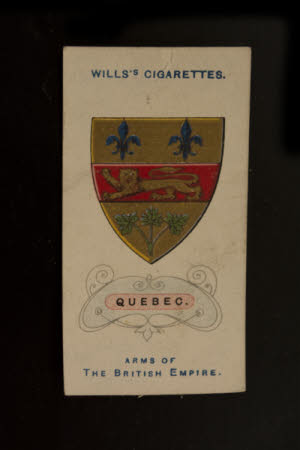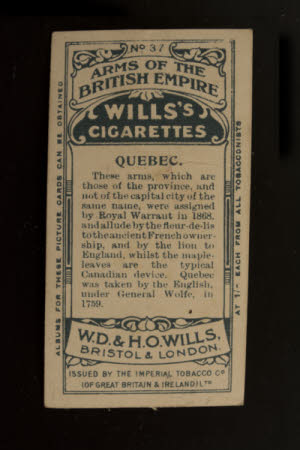Stamp
Category
Ephemera
Date
Unknown
Materials
card
Measurements
35 mm (Width) x 0.5 mm (Depth); 68 mm (Length)
Order this imageCollection
Mr Straw's House, Nottinghamshire
NT 749273.4.37
Summary
One of a set of 50 of Will's Cigarette cards 'Arms of the British Empire'. The first of three partail sets of cigarette cards kept in a wooden box with two compartments, a metal hinged lid painted red with a yellow / orange flower and card suit design. On the front of the card, at the top, is the title 'ARMS OF THE BRITISH EMPIRE.' To the left of the central coat of arms image it reads 'WILLS's, and then to the right 'CIGARETTES.' Beneath the image is the location the arms originate from, ‘QUEBEC.' The central coat of arms consists of a shield split into three horizontal sections. The top band shows two blue fleur-di-lis on a gold background, the central band a gold lion facing left on red background, and the lower band three green maple leaves on a gold background. On the rear of the card is decorative scrolling and the text at the top reads 'No37 ARMS OF THE BRITISH EMPIRE, 'WILLS'S CIGARETTES. The text at the base reads 'W.D. & H.O. WILLS.' BRISTOL & LONDON. ISSUED BY THE IMPERIAL TOBACCO Co. (OF GREAT BRITAIN & IRELAND)Ltd' Down either side of the card there is text running vertically which in its entirety reads 'ALBUMS FOR THESE PICTURE CARDS CAN BE OBTAINED AT 1/- EACH FROM ALL TOBACCONISTS.' In the centre of the rear of the card the decoration creates a box for information specific to the location portrayed on the card. In this instance it reads 'These arms, which are those of the province, and not the capital city of the same name, were assigned by Royal Warrant in 1868, and allude by the fleur-de-lis to the ancient French ownership, and by the lion to England, whilst the maple leaves are the typical Canadian device. Quebec was taken by the English, under General Wolfe, in 1759.'

